DISCURSOS - Rotary International
DISCURSOS - Rotary International
DISCURSOS - Rotary International
You also want an ePaper? Increase the reach of your titles
YUMPU automatically turns print PDFs into web optimized ePapers that Google loves.
Strengthening <strong>Rotary</strong>’s Brand<br />
William B. Boyd<br />
Past RI President<br />
In 2006 and in 2010, <strong>Rotary</strong> conducted surveys that told us something that you and I probably<br />
knew: Many people had never heard of <strong>Rotary</strong>, and of those who had, very few knew what<br />
we did.<br />
We spend large amounts of money on Public Relations Grants, yet our membership has not<br />
grown and we have not attracted large donors to support our work. The RI Board recognized that<br />
if we continued to do what we were doing, we would continue to get the same results, and it<br />
decided to employ branding experts to help us develop the tools we need. After a rigorous selection<br />
process, the Board contracted Siegel+Gale, an international consultancy, and formed a committee<br />
of directors and trustees to work with them.<br />
What is branding? Our brand explains simply and clearly who we are, what we do, and why it<br />
matters. Unfortunately, we had allowed our wonderful <strong>Rotary</strong> brand to become complicated and<br />
confused, and it was time to look for ways to strengthen it. This was not about reinvention or<br />
creating a new brand but about bringing focus to it.<br />
Siegel+Gale began the assignment by conducting wide-ranging research both inside and outside<br />
<strong>Rotary</strong>, and this research brought out some clear directions for us to take. They learned that<br />
Rotarians sometimes find it difficult to express who or what we are, and that we need to understand<br />
ourselves before we can successfully educate the general public.<br />
This independent review by outside consultants brought out some interesting viewpoints as well<br />
as identifying what it is that makes us what we are. They found that we speak our own language<br />
to one another, using words that are not used generally. For example, use the phrase “sergeantat-arms”<br />
with strangers and you will find yourself in a lengthy discussion! And we use a different<br />
language in our written materials. The style is stilted and formal.<br />
We have too many mission statements, and Siegel+Gale identified well in excess of a hundred<br />
logos, many of which have no obvious connection to <strong>Rotary</strong>. Our publications focus on the howto<br />
rather than the why when most people today are much more interested in outcomes. While<br />
we are proud of what we call our international service, we talk about it incessantly and miss out<br />
on promoting other strengths.<br />
Whenever Siegel+Gale talked to Rotarians, they found that the words “leaders” and “leadership”<br />
always came into the conversation, yet they were missing from all our publicity materials.<br />
The perception gap between internal and external audiences is huge.<br />
As the consultants looked at the positives, they found many strengths that we take for granted.<br />
We connect very well among our club members, among clubs, with our communities, and with<br />
those who can help us in what we do.<br />
We are an organization of responsible leaders, both socially and ethically. We gain strength from<br />
our classification system, which brings so many vocations together. Our diversity of membership<br />
is a plus because it helps us see and think differently from any other organization.<br />
They found that Rotarians join clubs to make a positive impact in their communities and for<br />
friendship, and they stay for the same reasons.<br />
36 <strong>International</strong> Assembly Speeches 2013


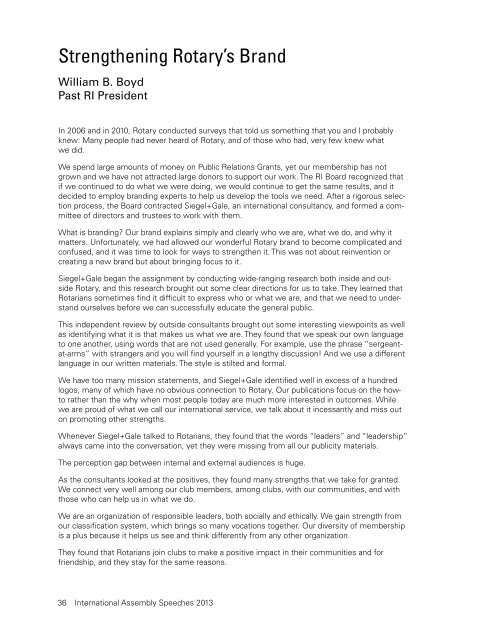
![La présidence du club [222-FR] - Rotary International](https://img.yumpu.com/25855726/1/190x245/la-presidence-du-club-222-fr-rotary-international.jpg?quality=85)
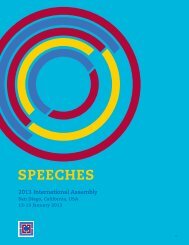
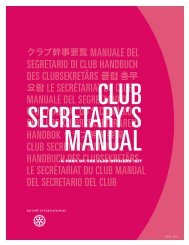
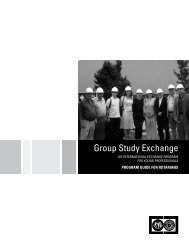
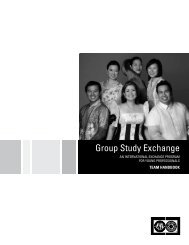
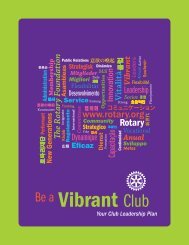
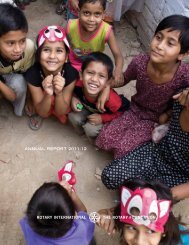
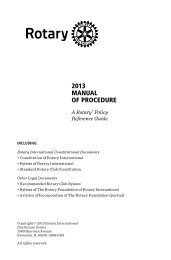

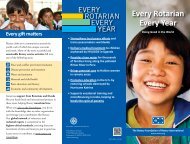
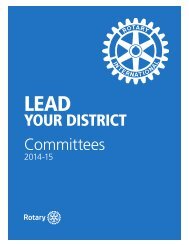

![La conférence de district [800-FR] - Rotary International](https://img.yumpu.com/25855636/1/190x245/la-conference-de-district-800-fr-rotary-international.jpg?quality=85)
